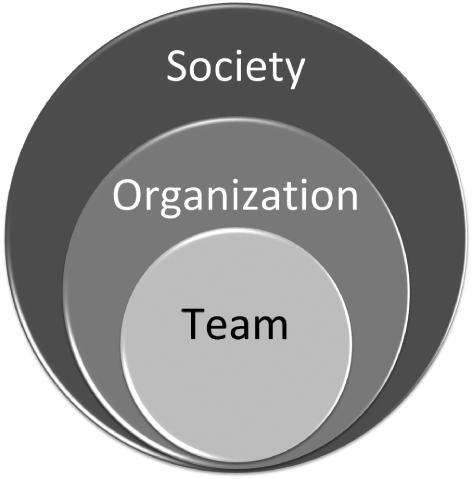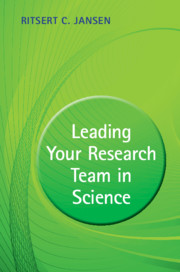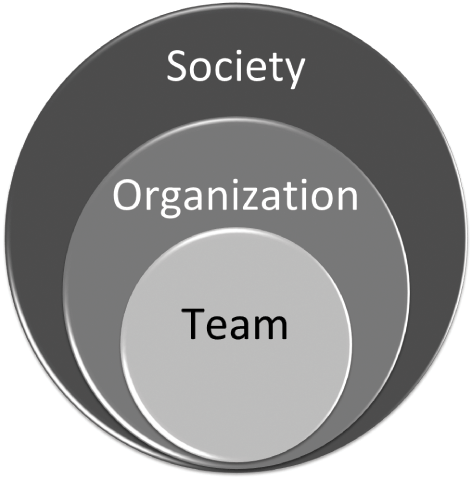Who is this book for?
This book is for researchers who lead, or want to lead, their own team to carry out their research plans. It is also for staff who provide support to researchers to help make these plans come true: specialists in human resources, communication, information technologies, finance, knowledge transfer, legal affairs and contracts, learning and teaching, and any other issues important to the day-to-day and longer-term business of research. So what’s in it for you? I will outline what you can expect to find in this book here.
You’re a team leader or aspiring to become one. You’re passionate about science. Your dreams might lie in the exact sciences (biology, chemistry, mathematics, or physics) or in one of the other sciences (medical, behavioral, economic, historical, or social sciences). You’re convinced that your ideas will extend the frontiers of your research field. And you dream of having a successful team of dedicated people working with you. How do you make this come true? Today’s reality in academia is that it’s not enough to be an expert in a particular scientific area; you also need to be multitalented in a range of skills to get your daily academic “business” done. You need to have a nose for the best opportunities and antennas alert for serious threats. You need to be able to “sell” your plans well to attract the necessary funds. You need to recruit the right people and create a team that can work well together. You need to justify to the funding agency and the public why their investment in you is a wise one. You need to know when to protect an intellectual contribution before sharing it openly. There are many more “you need’s.” Here is a final one: you need to spend your allocated research time as much as possible on doing true research with your team. How can you ever achieve this? If there is an answer, then it could look like this: research is teamwork, and today’s teams are more than ever a union between talented scientific staff and talented support staff. Get to know what these support staff can offer you. Learn to understand their language, and help them to understand yours. Get them truly engaged in your work, and let them support, guide, advise, and educate you and contribute their share to the teamwork. And last but not least, include them in your research successes. Take the lead, become entrepreneurial: it is up to you to make your science a successful business. I trust that this book will trigger you to do just that extra bit, that the passion and performance of your team together will greatly exceed the sum of the individuals’ contributions.
You provide support services. Perhaps you work in a university support department. You have great colleagues, in-depth knowledge about processes and procedures in academia, and some basic understanding of what the scientists actually aim for in their research projects. But these scientists are so specialized and sometimes they’re rather odd characters too, so it may be a continual challenge to understand and support them. However, it’s worth investing time and effort to engage with them and understand a bit about their work. How do you convince them that your expertise can add value to their research business? That together you can make their science affairs work better, hopefully much better? Step into their shoes, figuratively. What is really meaningful to them? What will make them feel well supported? You’re an expert not in their field but in your own. Like them, know your environment: what do your peers in support departments at other universities offer? Take a look at the websites of top (and other) universities. Go to national and international meetings on research services, and offer to give oral or poster presentations on your experience. Read the literature – not only business books written in your language but also academic journals such as Nature, Science, Trends in … , Public Library of Science, or Chronicles of Higher Education. Such journals regularly publish articles about the business of science too. Let your science colleagues know that you are at the forefront of your field, and prove this to them. This aligns you with the scientists. Ultimately, why not consider publishing your department’s vision, stories, or best practices in those journals too? It may help to convince the scientists you support and your management that your ideas will make a difference. Now demonstrate your expertise, passion, and ambition to work with your organization’s scientists. Researchers need to trust that you do what you say you are going to do (credibility), do it when you say you’re going to do it (reliability), do it in a way that is sensitive for researchers’ characters (intimacy), do it to serve the interest of the research and researcher and not just your own (orientation), and do it well (effectiveness and efficiency).Footnote 1 By contributing to the work of successful scientists, their positive recommendations will raise your reputation and justify your role.
Note:
In the rest of this book, “you” refers to the ambitious scientist who wants to make science his or her business by building up an effective team of coworkers. If you are not a scientist but a support staff member, then every time you read “you,” it is an invitation to step into the shoes of an ambitious scientist.
How is this book structured?
This book has three chapters to help you do all of this and to do it well:
| Chapter 1 | Team describes how you can build up an effective team of Master’s and PhD students, postdoctoral researchers, and other staff, such as technicians. Join forces with staff from human resources to optimize your most important research resource: the people. |
| Chapter 2 | Organization describes the formal organization of your team: how to manage the finances, protect intellectual property, and negotiate legal contracts. Learn about the official rules, procedures, and processes of your institution. Join forces with staff in financial, legal, and human resource services, as well as in the knowledge transfer office. |
| Chapter 3 | Society describes how to address your peers, the public, and other parties who want or need to know about your project and its results. Enhance the visibility and publicity of your work by allowing open access to information, by involving nonacademics in the work, and by using traditional and modern media to share outcomes. Join forces with staff from information technology, library services, and communication services. |
The three chapters and the various sections can be read sequentially or be dipped into ad hoc. Read and use the information in your own way. The “messages” in the sections are illustrated by anecdotes from starting, consolidating, and advanced researchers as well as from alumni who work outside academia: stories can speak louder than anything else. All these stories are presented in the first person, and some details have been changed to protect the privacy of the people who have shared their stories with me – but all the stories are based on true events. The messages in these sections have also been translated into various “TRY THIS!” exercises to help you sharpen your thoughts. You can do most of these exercises on your own, but you may benefit from interaction at a research group retreat, in an ad hoc peer discussion session you organize, or in a course for young team leaders.

Figure Intro.1 The three parts of this book
The trilogy
This book is the third part of a triology for “early career researchers at work.” The first book, Developing a Talent for Science (Reference Jansen2011), discusses essential behaviors and skills. It offers guidelines on how to develop your own talent, how to use other people’s talent, and how to develop other people’s talent. The second book, Funding Your Career in Science (Reference Jansen2013), discusses proposing projects and getting them funded. It offers guidelines on how to get novel research ideas and convert them into successful project proposals. This third book, Leading Your Research Team in Science (2019), completes the trilogy and discusses managing funded projects. It offers guidelines on how to deal successfully with all the associated responsibilities.
Disclaimers
This book offers an introduction to a range of issues in the domains of human resources, finance, and legal experts and others such as lawyers and patent specialists.
First disclaimer:
The information in this book does not aim to replace financial, legal, or any other professional advice. If you have questions, do contact a specialist, e.g., a human resources officer, project controller, or patent lawyer. How specific issues should be dealt with will differ between countries, between universities in the same country, and sometimes even between different institutes at the same university. Once you have read this book, however, you’ll have had a chance to think about such issues and be better equipped to handle such matters appropriately, knowing some of the general actions you need to take to make things happen.
Second disclaimer:
This book is not a scientific text. While reading it, try not to accept or reject anything right away; rather, taste, explore and consider, look up suggested further readings, and form your opinions later, as well as your own vision, strategy, and plans for your science business. Do it your way!


